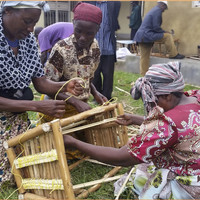Bwindi: bees, baskets and brilliant guided walks
Tracking rare mountain gorillas is on the bucket list of many a traveller – both at the luxury end of the market and for backpackers. But what about the people who live in the same places as gorillas? Dilys Roe reports on a project helping local people to develop new businesses that benefit from tourism.


Bwindi is famous for its mountain gorillas – but there are other attractions (Photo: Dilys Roe/IIED)
Many tourists forget that Uganda’s Bwindi Forest is not only home to almost half the world’s population of mountain gorillas but it is also in one of the most densely populated areas of rural Africa. Over 100 villages are home to approximately 70,000 people, including 1,000 indigenous Batwa people who were evicted from the forest when it was declared a national park in the early 1990s.
While living alongside gorillas sounds like a wildlife enthusiast's dream, for poor farmers such as those at Bwindi, it can mean significant costs when gorillas – or other species – wander out of the forest and onto adjoining farmland, destroying vital crops.
Local people do get some benefits from the gorillas, and from the tourists that come to see them. The Uganda Wildlife Authority allocates a proportion of the income it makes from park entry fees and gorilla tracking permits to fund small social development projects including clinics, schools, livestock projects and other initiatives. And local entrepreneurs have also tried to cash in by establishing craft shops, providing dancing displays or trying to sell eggs, potatoes and other produce to the tourist lodges.
But overall, local people don’t feel that they benefit as much as they could, or should, from tourism. And this is turn can engender a sense of resentment against the park and against gorillas.
One reason for the limited benefits for local people is that gorilla tourists don’t hang around. They often arrive late one day, track gorillas the next day and then leave early on day three, spending most of their down time at their lodge. Or if they do venture out to explore local attractions they find that the products on offer are not what they want – either in style, quality or authenticity.
Creating change
IIED led a project that aimed to change this pattern. From 2016 to 2019, we partnered with tourism professionals and local conservation and research organisations on a range of initiatives. We surveyed tourists and tour operators to find out what they would be tempted to buy if it were available, and found that quality crafts, authentic cultural experiences, guided nature trails and local produce were in high demand. So we responded:
- Ugandan artist Sanaa Gateja trained local women to make unique 'Bwindi Baskets' featuring bespoke designs and based on all natural materials and dyes
- Ugandan businessman Brian Mugisha, owner of Golden Bees honey company, trained local beekeepers in how to construct improved hives and produce honey to export quality standards
- International tourism professional Peter Nizette and Ugandan professional safari guide Johnnie Kamugisha trained a group of young 'Bwindi Specialist Guides' and helped them design and market three new walking trails that visit natural and cultural attractions, and
- Local agricultural extension worker Honest Tumuheirwe trained groups of market gardeners (some of them ex-poachers) to grow the kinds of horticultural produce that tourists want to eat – and to a quality standard that lodges want to buy.
Answers to vital questions
Our project was trying to find the answers to three key questions:
Would tourism skills training result in increased sales of local products and services to tourists, tour operators and lodges?
The answer to this was a resounding YES! We worked with 14 small enterprises, and the numbers of tourists visiting, and purchasing from them, increased by a factor of 10 in some cases – and at least tripled in all cases.
Local tour operators have started to feature the walking trails in their Bwindi itineraries, and more lodges have started to buy local produce from the market gardeners (and many of those that were already buying locally have bought more or more regularly).
Would increased sales make a difference to local people’s liveilhoods?
Another YES! Over 400 local people were able to gain new or improved skills from our training. The majority (64%) of the people involved reported that their income had increased as a result. And where it didn’t, this was usually due to factors beyond the project’s control (new bee hives failing to colonise, for example).
But it was what people could do with the extra money that really made a difference. We were told: “I have been able to install solar to my house and children can now read at night” and “After selling honey and vegetables to the park staff and lodges I managed to pay school fees in time”.
And what about the gorillas? Would increased benefits from tourism improve local attitudes towards them and the park?
A third YES! We surveyed local people at the beginning and end of the project and found that more people described their relationship with the national park as positive after the project. And, significantly, people that had been involved in the project felt more positive towards the park than others in the community who had not been involved.
Our Bwindi trainees go from strength to strength. Just last week we heard from one handicraft cooperative that they had made UGX1.3 million (US$350) from basket sales to a group of tourists in one hour – “that used to be our monthly sale!”.
So, next time you think about gorillas, or gorilla tracking, think as well about the people that live alongside gorillas and what they might have to offer. Tourism is a joy for those that can afford it. It can also be a lifeline for people who live in places we like to visit.
Bwindi photo gallery
Click through this gallery (click on the images to expand them) to discover more about how we helped improve the livelihoods of local people and contribute to Bwindi's long-term future.

















